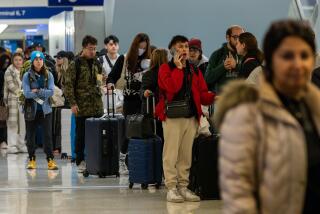Panic, not Ebola, is biggest enemy, civic and health leaders say

There have been no confirmed cases of Ebola so far in Southern California, but anxiety over the disease has taken root.
On Friday morning, health officials in Ventura County quelled rumors of a potential Ebola patient in Thousand Oaks. The patient did not have the virus but had recently returned from overseas and grew concerned when he started feeling sick, even though he hadn’t traveled where Ebola was a danger.
Later in the day, the Patsaouras Transit Plaza in downtown Los Angeles was shut down for 90 minutes when a feverish rider from Nigeria — again, not a country of current Ebola concern — complained of nausea on an LAX FlyAway bus.
The events were part of a pattern of panic that has started to worry some in the region. Responding to a report on Ebola preparedness last week, Los Angeles City Councilman Paul Krekorian lamented the public terror over a virus that, to his reckoning, was unlikely to harm anyone here.
“There is no Ebola crisis,” Krekorian said, adding that he worried what would happen as flu season unfolds and large numbers of Southern Californians come down with fevers and aches. “Is there some way we can relieve people of that fear so our emergency rooms are not crowded with people who are fearing they have Ebola because they saw someone throw up, or have a runny nose?”
As the region settles in for what is likely to be months of vigilance, health officials and medical providers must pull off a balancing act, keeping Angelenos calm and focused on more likely health threats — including influenza, which sickened thousands and killed more than 100 people in Los Angeles County during the 2013-14 flu season — as they doggedly seek out potential Ebola cases coming into the region.
“We’ll have a lot more people who die of influenza than we’ll ever have for Ebola,” said Dr. Robert Kim-Farley, director of the Los Angeles County Department of Public Health’s division of Communicable Disease Control and Prevention. “But given that there are over 9,000 cases in West Africa, we’ll have the potential that someone could come over.… We can’t have complacency. This isn’t business as usual.”
Los Angeles area providers have been busy trying to make sure they’re prepared to encounter a potential Ebola patient — assembling protective gear, reviewing protocols and conducting training, said county interim health officer Dr. Jeffrey Gunzenhauser, during a phone call with reporters Friday.
The region’s medical system has been affected, but not overwhelmed, by Ebola fears thus far, officials and healthcare providers said last week.
Cathy Chidester, director of the county’s Emergency Medical Services Agency, was not aware of any Ebola-related uptick in 911 traffic. Although one prankster caused a stir Oct. 13 by boarding an MTA bus and shouting, “Don’t mess with me — I have Ebola!” Chidester said she wasn’t concerned about hoaxes pouring into dispatch centers.
Kim-Farley would not specify how many Ebola-related calls his team had fielded but said there had “not been a lot of cases of concern.”
Dispatchers and others on the medical front lines can rule out Ebola very quickly most of the time, he said, because a person must have either traveled to an Ebola-stricken part of Africa or have been in close contact with an Ebola patient to worry about getting the disease.
Ebola can pass from person to person only through infected bodily fluids such as blood, vomit or diarrhea and does not spread through the air. A simple question about travel and contacts, posed over the phone or at a triage desk, can rule out the possibility of infection.
“You have to have the unusual travel history,” he said. “And very few people have traveled to Liberia, Guinea or Sierra Leone within the preceding three weeks.”
County hospitals had managed only about seven or eight cases where travel histories seemed initially worrying, said Dr. Christina Ghaly, deputy director of strategic planning for the Department of Health Services.
Most concerns were ruled out quickly. In a couple of cases, county hospitals conducted Ebola testing, but results were normal, Ghaly said.
Dr. Daniel Uslan, an infectious-disease specialist at UCLA Medical Center, said most calls to his health system had come from patients concerned about preparedness.
“It’s not ‘I’m worried I have Ebola.’ It’s ‘I’m worried you’re not doing enough to prepare,’” he said. “We haven’t gotten frantic calls. People realize it’s an isolated problem.”
But Uslan said UCLA had encountered a small number of sick patients whose travel histories or symptoms had given triage teams pause.
“After questioning, it was dismissed, but it provokes anxiety and resource use,” he said, adding that he worried the problem would intensify as more people come to the hospital with influenza-related fevers.
Typically, most flu cases arise between December and March, with a peak around Valentine’s Day, Uslan said.
As of Tuesday, Uslan had not heard about any confirmed influenza cases at UCLA yet this season. But seven Kaiser Permanente patients had tested positive for flu in the preceding two weeks, said Dr. Kalvin Yu, regional chief for infectious diseases at Kaiser Permanente Southern California.
Yu said infectious-disease doctors on his team, who field calls from throughout the Kaiser network, were feeling Ebola’s effect.
“We’re getting paged more from people in urgent care with nausea and vomiting, or a fever,” he said. “It’s definitely a different experience being on call than it was two months ago.”
Kaiser Permanente is pushing influenza vaccination as part of its Ebola response. If more Southern Californians get their flu immunizations, Yu said, “you decrease the number of people who are coming in with symptoms that would potentially overlap with Ebola.”
In the meantime, even if vaccine uptake is high, there will be more scares.
Following Krekorian’s remarks at the Tuesday City Council meeting, county interim health officer Gunzenhauser said that fear was to be expected and that he was encouraged when people called with concerns, because it showed they were paying attention.
“As we respond to these incidents ... I’m certain the public will be more calm and we’ll see less and less of this,” he said.
UCLA’s Uslan said medical workers would take the potential cases seriously, even if it seemed like overkill at times.
“You’ll see people overreact, appropriately so, until we’re comfortable someone doesn’t have risk factors,” he said. “What we don’t want to happen is a ‘boy who cried wolf’ scenario. We don’t want to miss that one patient who doesn’t have the flu.”
Twitter: @LATErynbrown
Times staff writers Veronica Rocha and Laura Nelson contributed to this report.
More to Read
Start your day right
Sign up for Essential California for news, features and recommendations from the L.A. Times and beyond in your inbox six days a week.
You may occasionally receive promotional content from the Los Angeles Times.







